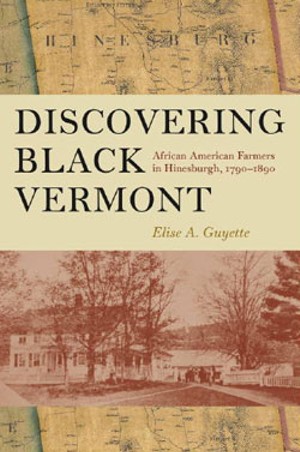Published May 19, 2010 at 4:27 a.m.
Lincoln Hill is the official name conferred on a lonely corner of Hinesburg in honor of the president who decreed the end of slavery. South Burlington-based historian Elise A. Guyette, in her new book about the black families who farmed and thrived there for 70 years, refers to it simply as “the Hill.” But for decades, in a less racially sensitive time, it went by the stark name “Nigger Hill.” A few call it that still.
Viewed in isolation, the slur suggests these generations of Vermont African Americans were subjected to bitter, relentless racism. Maybe they were … and maybe not.
There’s a lot at stake in the story Guyette tells in Discovering Black Vermont. Does Vermont deserve its reputation as a refuge of racial tolerance during the slave era, and beyond? Or, as today’s revisionist historians argue, is the state’s self-image really a self-delusion? Despite its pioneering prohibition of slavery, was Vermont, at the grassroots level, just as racist as the other New England states?
At the very least, white Vermonters displayed hurtful ignorance by using a toxic term to describe a part of their geography. Similar names were given to about a dozen roads, swamps and hollows around the state, notes Norwich University history professor Ray Zirblis. He sees that as a reflection of the “corrosive, poisonous elements of racism that were present in Vermont on a day-to-day basis.”
Others maintain that the “N-word” was used as a form of slang by rural folk with no understanding of its power to wound and enrage. “It wasn’t meant in a derogatory way,” says Jean Miner, president of the Hinesburg Historical Society. “There was no discrimination here toward black people.”
Indeed, Guyette’s deep research unearthed no direct evidence of prejudice displayed against the black Clark, Langley and Peters families from 1790 to 1890, the period that her book covers. “This narrative is not one of oppression,” she writes. On the contrary, Guyette finds indications of interracial collaboration or full-fledged friendship among blacks and whites on the Hill. She also documents examples of racial justice on the part of local institutions such as the churches and the courts.
At the same time, the author strives to situate her specific story in the context of race relations in the United States during those decades. And, given what we know about the pervasive, often violent hatred for black people in white America, there is persuasive reason to assume, as Guyette suggests, that the African-descended residents of the Hill experienced racist abuse.
Guyette discusses the “Nigger Hill” term only in a footnote in her book. She recalls being told by an African American Vermont state trooper that, soon after joining the force in the 1990s, he was dispatched to a road designated by that name on police maps. In 2008, Guyette adds, she was telling a former Hinesburg teacher about her research on Lincoln Hill. “You mean Nigger Hill,” the man corrected her.
Guyette, who works through the University of Vermont to make K-12 curricula more inclusive of minority perspectives, has produced a dispassionate work of scholarship heavily reliant on primary sources. Discovering Black Vermont seeks to chronicle a small mixed-race community by combing through official records such as wills, property deeds and census data. Much of the book involves painstaking analysis of a fairly small set of facts. The story lacks inherent drama, although Guyette is capable of graceful writing and, at a few points, allows an undercurrent of anger to rise to the surface.
These muffled eruptions occur when Guyette steps back from her material to make general observations and engage in speculation. Most troubling to her is not what the historical records reveal but what they conceal. Guyette’s introduction to the book starts with a quote from Playing in the Dark, a book of literary criticism by African American Nobel laureate Toni Morrison: “At some point the silence became an unbearable violence.”
By 1865, Guyette relates, the interrelated Clark and Langley families had departed from the 175-plus acres they once owned on the Hill, the last of that land having been sold off to the white Ross family. Visiting that area today, Guyette writes, “You will see a sign for ‘Ross Hill’ just over the line into Huntington. There are no signs for the Clarks or Langleys who first cleared and then farmed the ancient land and who are there still in the old burying ground.”
Yes, several African Americans probably are interred not far from that “Ross Hill” sign, but without any visible homage to their remains. Shubael Clark, the patriarch who settled on the Hill in 1795 with his wife, Violet, initially had his life commemorated by a large stone monument, but it was destroyed by vandals at some point in the 20th century. Violet and their children and other relatives lie there, too, although the roadside burial ground is unmarked and contains only a few fragments of what may have been tombstones.
Standing in that overgrown plot one recent rainy Saturday, Guyette remarks, “If the Clarks and Langleys had been white, I don’t think they would have gone away from here.” They may have been forced somehow to abandon stable, even prosperous homesteads, Guyette suggests. African American families who sent their sons and grandsons to fight for freedom in the Civil War may have been made to feel unfree themselves on that hill in Hinesburg.
“Vermont exceptionalism” — the view of the state as different from and superior to other states in its race relations — is “only a story we tell ourselves,” in Guyette’s estimation. It’s the self-congratulatory product of historical amnesia, she suggests. The book notes, for example, that some black Vermonters remained enslaved for many years following the state’s celebrated constitutional ban on slavery in 1777. But that’s “no longer part of our historical memories,” Guyette remarks.
And, while Vermont did have a sizable abolitionist movement, Guyette points out that antislavery sentiment should not automatically be equated with antiracism. Many Vermont abolitionists believed that blacks could not or should not coexist with whites and that freed slaves would do well to migrate to Africa. Moreover, the mobs that attacked radical abolitionist speakers in Newbury, Randolph and Montpelier were composed of ordinary Vermonters.
“It’s unquestionable that black farmers would have encountered racism in Vermont,” says Kari Winter, the SUNY Buffalo historian who a decade ago rediscovered The Blind African Slave, the 19th-century autobiography of St. Albans resident Jeffrey Brace. “There was no space in the Western world outside the realm of racism at that time,” Winter comments.
Jane Williamson, director of the Rokeby Museum in Ferrisburgh, agrees that “white Vermont was not outside the mainstream of America. It was racist.”
Guyette herself came to this work out of dismay that her own French Canadian and Irish heritage had been omitted from the Yankee-centric history texts she read in elementary school in Rutland and later taught to fourth graders in Swanton.
Despite all this, however, readers may come away from Discovering Black Vermont with a reaffirmed belief that the state truly was different — and better.
“On this Hill,” Guyette writes, “black and white neighbors would come to work together, pray together, and even loan each other farm animals when the need arose.” She makes a case for at least limited exceptionalism when she adds, later in the book: “Even though racism was widespread in the North, two families on the Hill [the black Clarks and the white Yaws] illustrate that positive cross-racial relationships existed and even continued after they left Hinesburg.”
Shubael Clark was chosen as a leader in his overwhelmingly white Baptist church. And Guyette takes note of a court case involving William Langley, a black Hill farmer, that “belies the traditional narrative of ubiquitous hatred and virulent racism directed toward people of color at this time [1842].” Langley “had not only testified against white people in court, but won his case against them. The judiciary had shown an even hand, with no racial favoritism.”
Defying the ultimate racial taboo, blacks and whites in Hinesburg and elsewhere in Vermont also became lovers and spouses.
The black Peters family, which lived at the bottom of the Hill for generations, had so many members intermarry with whites that their descendants became “bleached,” Hinesburg Historical Society head Miner notes, using a term that she says was common among African Americans in the town.
Amy Mincher, a Plymouth-based historian, is scheduled to speak at Rokeby on Sunday about her research involving a black Middlebury farmer, Prince King, who lived for many years with a white woman, Miranda McHurd. The neighbors discreetly referred to McHurd as King’s “housekeeper,” Mincher reports. The couple now lie side by side in marked graves near their homestead on Munger Street.
Intimate relations across the color line could simply show, as Rokeby’s Williamson suggests, that blacks “didn’t have many other blacks to marry” in the 99 percent white Vermont of the 1800s. But these romantic partnerships can also be seen as confirmation of Guyette’s hypothesis that at least some white and black Vermonters “created their own way of living in a biracial community despite a racist culture.”
Heartening, too, is Guyette’s suggestion that blacks on the Hill seem to have “identified more as rural Vermont farmers than as African Americans.” Could it be they felt a strong allegiance to a state that truly did treat them as equal citizens? A hint of that appears at the close of a letter sent to the Anglo-African Paper in 1864 by Loudon Langley, a black Union soldier from the Hill. He signs his complaint about unequal pay rates for blacks and whites “A Colored Vermont Recruit.”
“His signature gives us insight into his own identity — the way he wanted to be seen by those reading the paper. He was a man of color but also a Vermonter,” Guyette notes. “Born and raised in the hills of northern Vermont, of Vermont-born parents, he must have been proud of his birthplace.”
The Rokeby Museum opens this Sunday, May 23, with a 2 p.m. presentation by Amy Mincher on Middlebury farmer Prince King, and author Elise Guyette will sign copies of her new book. Route 7, Ferrisburgh, 877-3406.
More By This Author
About the Artist

Matthew Thorsen
Bio:
Matthew Thorsen was a photographer for Seven Days 1995-2018. Read all about his life and work here.
Matthew Thorsen was a photographer for Seven Days 1995-2018. Read all about his life and work here.
Speaking of...
-

Totally Transfixed: A Rare Eclipse on a Bluebird Day Dazzled Crowds in Northern Vermont
Apr 10, 2024 -

Q&A: Catching Up With the Champlain Valley Quilt Guild
Apr 10, 2024 -

Video: The Champlain Valley Quilt Guild Prepares for Its Biennial Quilt Show
Apr 4, 2024 -

Q&A: Digging Into the Remnants of the Ravine That Divided Burlington
Mar 27, 2024 -

Video: Digging Into the Ravine That Divided Burlington in the 1800s
Mar 21, 2024 - More »
Comments
Comments are closed.
From 2014-2020, Seven Days allowed readers to comment on all stories posted on our website. While we've appreciated the suggestions and insights, right now Seven Days is prioritizing our core mission — producing high-quality, responsible local journalism — over moderating online debates between readers.
To criticize, correct or praise our reporting, please send us a letter to the editor or send us a tip. We’ll check it out and report the results.
Online comments may return when we have better tech tools for managing them. Thanks for reading.














































